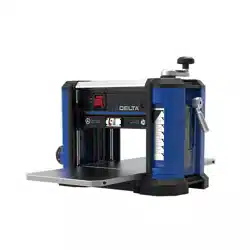Loading ...
Loading ...
Loading ...

15
SNIPE
Snipe is a depression made when an unsupported end of your material drops toward the oor, causing the opposite end to lift up
into the cutter head.
TO AVOID SNIPE
• Feed the workpiece into the planer so it is level and remains at against the table at all times.
• KEEP the workpiece level throughout planing operation by receiving or “catching” it from the rear of the planer. If you are
planing material that is especially long, the use of additional material support is recommended.
TWISTED, CUPPED AND BOWED WOOD
If both sides of your material are very rough or if the material is cupped, bowed or twisted, your planer may not produce the desired
result. Ideally, you should have at least one at surface/face on your material before you plane. Your thickness planer will work best
with material that has been run through a jointer to produce one at surface. If you DO NOT have at least one at surface or a
jointer, see the following recommendations.
TO PLANE TWISTED WOOD
Twisted wood may jam your planer. If a jam occurs, turn the power “OFF”, disconnect the power
supply and raise the cutterhead to release the workpiece from the cutter.
If your material is only SLIGHTLY twisted, plane both sides alternating from one to the other until the desired thickness is reached.
TO PLANE CUPPED WOOD
To obtain the best possible results with cupped wood, rip the material down the middle and plane it as two separate pieces. Ripping
the material reduces the severity of the cup and allows the machine to deliver better results. Understand that you will have to remove
more material on cupped wood to achieve the desired thickness than you would on a normal board. If ripping the material is not an
option, plane one side of the material until at, then plane the opposite side until it is also at. Start with the cupped portion of the
board facing down.
NOTE: DO NOT ip the board back and forth between each pass as recommended by the general planing directions.
TO PLANE BOWED WOOD
The feed rollers and cutter head in your planer will push the bow out of the material as it feeds. However, when the material exits the
planer, the pressure of the rollers and cutterhead will release allowing the wood to spring back into a bowed formation. To properly
remove the bow, use a jointer.
MAINTENANCE/ADJUSTMENTS
To reduce the risk of injury, turn unit off
and disconnect the machine from power source before
installing and removing accessories, before adjusting or
when making repairs. An accidental start-up can cause
injury.
Wear gloves when you remove the
knives for sharpening or replacement. The knives in
this planer are very sharp.
The knives are sharp. Be careful when
removing, handling, or installing knives.
The knives supplied with your planer are double edged and
reversible so that you can turn the knives end-for-end when
one edge becomes dull or chipped. To change the knives see
Figures 19 - 22.
1. Raise the cutter head assembly to 4 inch (102mm) on
the “Scale and Pointer”.
2. Remove the screws
A
. Pull the dust deector or dust
collection attachment – whichever is installed –
B
straight out.
3. Insert the supplied wrench
PC5
into the hex hole.
Rotate the cutterhead until the cutterhead lock
engages.
4. Remove the seven screws
E
and use magnetic end
of the wrench to remove the hold-down bar
F
.
FIGURE 19
FIGURE 20
OPERATION
PC5
A
B
CHECKING, ADJUSTING,
CLEANING AND REPLACING
KNIVES
Loading ...
Loading ...
Loading ...
